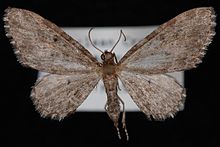Eupithecia lachrymosa
Appearance
| Eupithecia lachrymosa | |
|---|---|

| |
| Scientific classification | |
| Domain: | Eukaryota |
| Kingdom: | Animalia |
| Phylum: | Arthropoda |
| Class: | Insecta |
| Order: | Lepidoptera |
| Family: | Geometridae |
| Genus: | Eupithecia |
| Species: | E. lachrymosa
|
| Binomial name | |
| Eupithecia lachrymosa | |
| Synonyms | |
| |
Eupithecia lachrymosa is a moth in the family Geometridae first described by George Duryea Hulst in 1900. It is found in North America from central Saskatchewan west to southern Vancouver Island, north to British Columbia and Alberta and south to California.[3]
The wingspan is 19–24 mm. Adults are dark grey brown with obscure markings, except for a fairly prominent dark forewing discal dot.
The larvae feed on Betula papyrifera, Salix, Ceanothus, and Alnus species.[4]
References
- ^ Yu, Dicky Sick Ki. "Eupithecia lachrymosa (Hulst 1900)". Home of Ichneumonoidea. Taxapad. Archived from the original on March 25, 2016.
- ^ "910386.00 – 7548 – Eupithecia lachrymosa – (Hulst, 1900)". North American Moth Photographers Group. Mississippi State University. Retrieved May 2, 2019.
- ^ Rindge, Frederick H. (July 25, 1963). "Notes on and descriptions of North American Eupithecia (Lepidoptera, Geometridae)" (PDF). American Museum Novitates. 2147: 1–23.
- ^ Anweiler, G. G. (September 7, 2004). "Species Page - Eupithecia lachrymosa". Entomology Collection. University of Alberta E.H. Strickland Entomological Museum. Retrieved May 2, 2019.
Wikimedia Commons has media related to Eupithecia lachrymosa.
Wikispecies has information related to Eupithecia lachrymosa.
